The 12 Best AI Video Editors in 2025
Explore the best AI video editors changing content creation in 2025.
 June 9, 2025
June 9, 2025 12 minute reading
12 minute reading
Video is more important than ever. In 2024, 96% of marketers consider video—social media videos, explainer videos, and testimonial videos—important to their marketing strategy
However, videos can be one of the most time and resource-intensive forms of media to create. 30% of people lack the time to create video content. Some are reluctant to dive into post-production because of the steep learning curve with traditional editing tools like Premiere Pro, Final Cut Pro, and After Effects.
If video editing is holding you back from starting a YouTube channel or creating TikToks, Instagram Reels, or product explainer videos for your business, AI video editors are here to save the day.
Here are the seven best AI video editors on the market. We’ve highlighted tools for different video needs, along with their pros, cons, and the types of users they’re best for.
How AI video editors work
AI video editors sit on top of two core machine-learning breakthroughs: automatic speech recognition (ASR) and computer–vision–based scene understanding.
Modern ASR models—usually large transformer networks fine-tuned on millions of hours of video—convert the audio track into a time-stamped transcript with word-level accuracy.
On the visual side, convolutional and vision-transformer networks scan every frame to spot shot boundaries, scene changes, and even objects or faces.
Google’s latest generative-AI scene-detection stack, for instance, classifies hard cuts, dissolves, and semantic context so precisely that it can insert chapter markers or ad slots without human input. The same shot-boundary techniques power automatic “highlight” extraction and smart re-framing for vertical or square formats.
Those engines reshape the entire production workflow. A single recording can become eye-catching TikToks or Reels, captioned educational modules, or branded product explainers. Long livestreams, Zoom calls, and podcasts are automatically highlighted, subtitled, and exported in platform-ready formats—turning an hour of raw material into weeks of shareable content.
12 best AI video editors
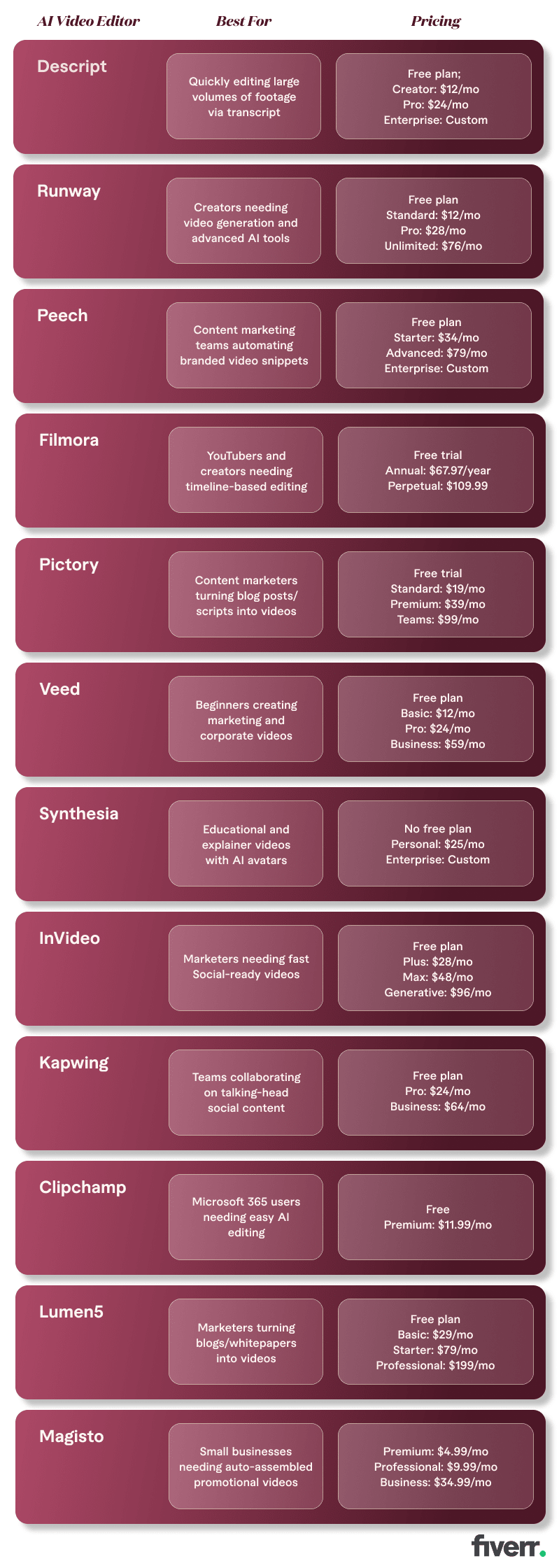
AI video editors
1. Descript
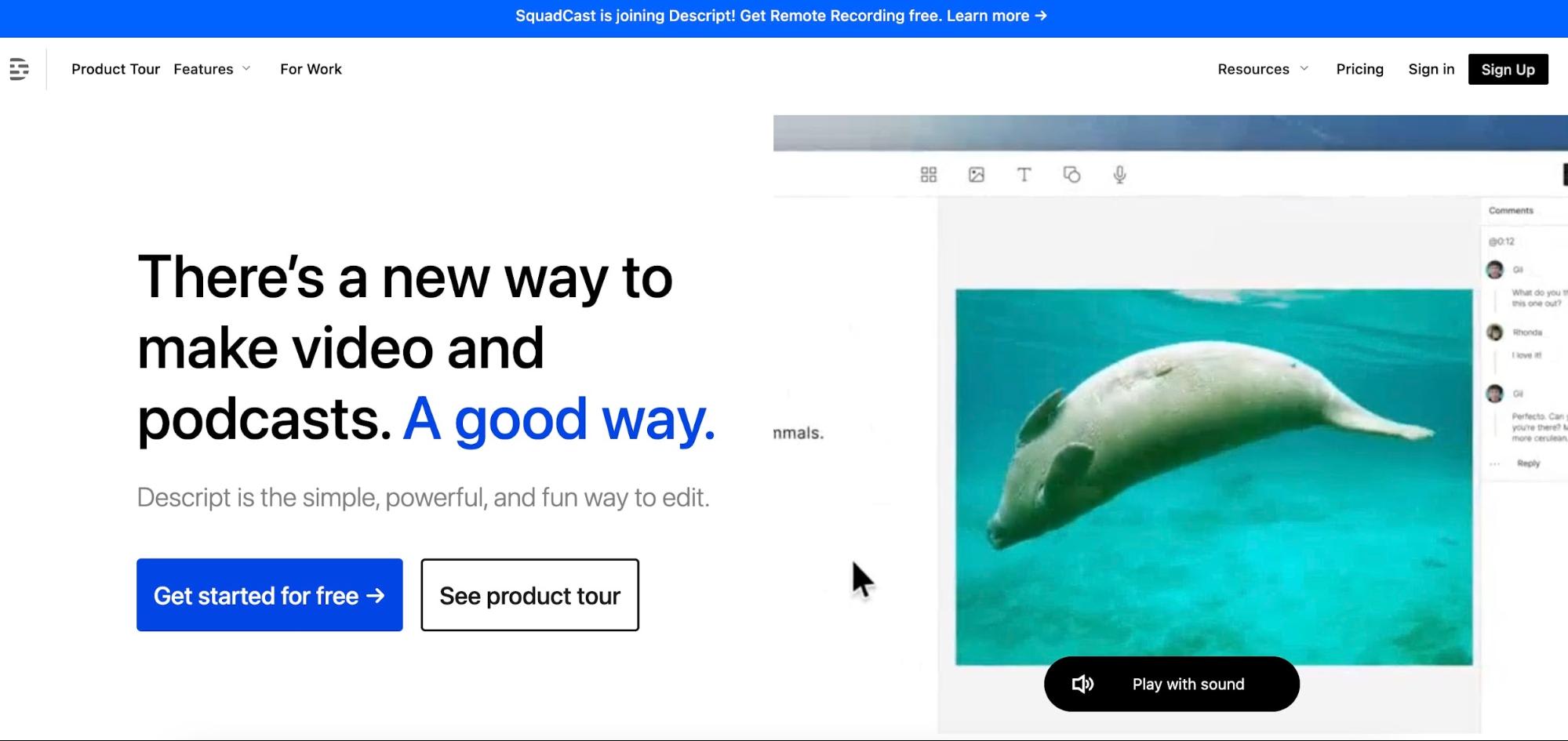
Descript
Descript is an AI-powered video editor that you can use to write, record, transcribe, and edit in one place. The standout feature is being able to edit hours of raw footage directly through the transcript. But if you’re used to traditional editing, such as Adobe Premiere Pro’s user interface, Descript also allows you to edit from the timeline and add effects manually.
Descript also lets you add B-roll stock videos, clone your own voice and overdub, or even remove filler words like “um” and “uh” from footage.
Video templates make it easier to quickly edit and add different styles or repurpose old content.
Pricing
Descript has a free plan that gives you basic video editing features: “um” and “uh” filler word removal, overdub, AI green screen, studio sound upgrade, and limited access to the stock footage. However, you can only export one watermark-free video a month in 720p.
Here are Descript’s paid plans:
Creator: $12 per month, billed annually. Includes unlimited video exports in 4K resolution, more transcription hours, and greater access to the stock library.
Pro: $24 per month, billed annually. Includes more filler words and repeated word removal, and 1 TB cloud storage.
Enterprise: Custom pricing for more features such as a security review, onboarding and training, and unlimited cloud storage.
Pros
Easy to use and beginner-friendly
All-in-one video editing solution
Timeline editing mode
Great for content repurposing
Great for short-form TikTok videos and Instagram reels
Cons
Screen-recording feature doesn’t work well
Overdub feature can sometimes sound unconvincing or unrealistic
Best for
Descript is the best AI video editing software for those who need to quickly go through large volumes of raw footage, thanks to its transcript editing feature.
2. Runway
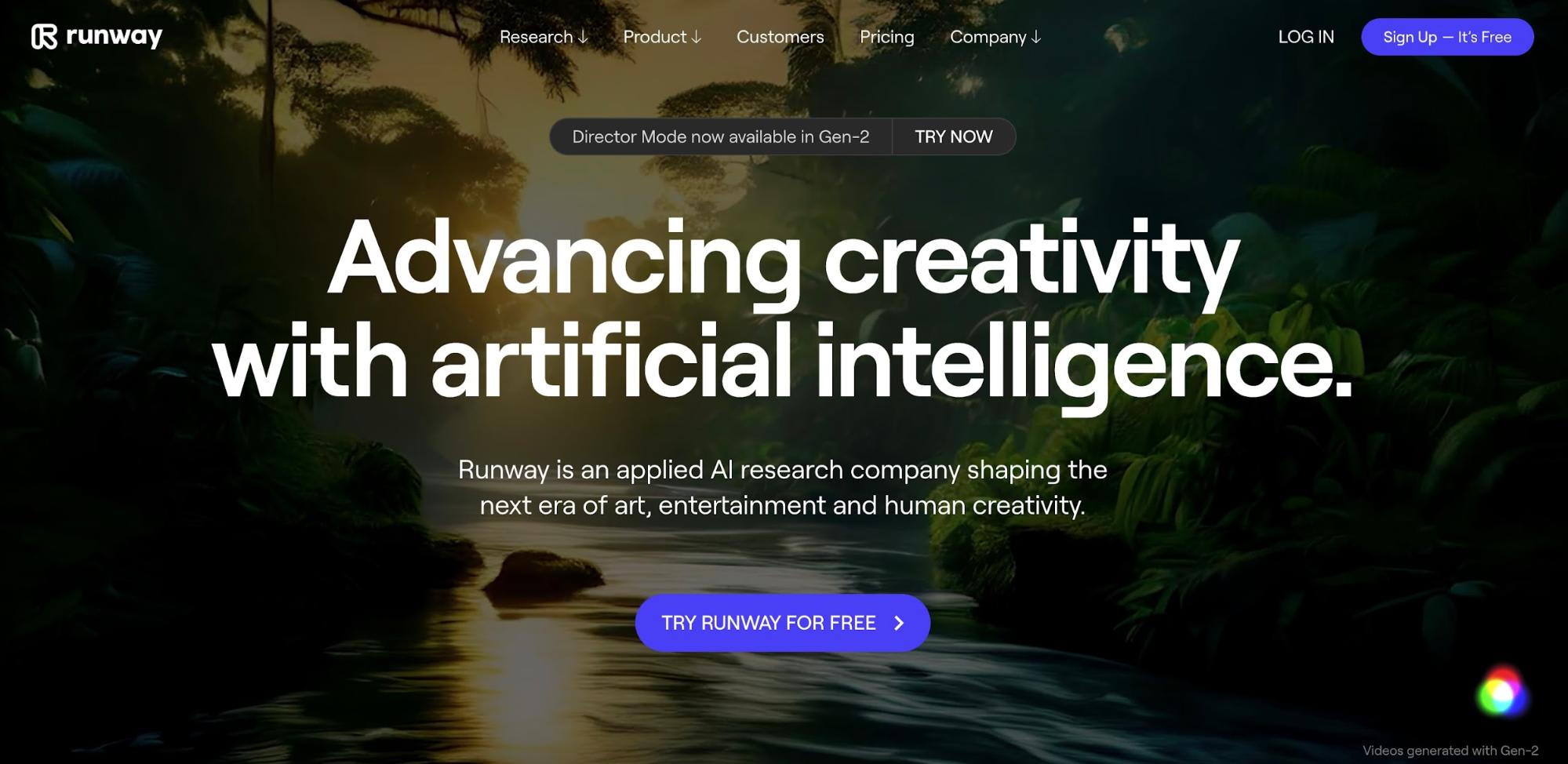
Runway
Runway is more than just an artificial intelligence video editor, and has a suite of more than 30 content creation AI tools, including AI art.
Runway’s primary AI models are Gen 1 (video-to-video) and Gen 2 (text-to-video)—multimodal artificial intelligence systems that can convert text prompts or images into film. In addition to this, Runway can perform:
Frame interpolation: Turning a series of images into video
Infinite image: Extending an image and adding details
Green screen editing: Changing the background of a subject in a video
Inpainting: Removing details or objects from a video and replacing them with content
Since it runs on a web browser, there’s no need to download software to use it. Using Runway can be daunting for a beginner, and the volume of tools can be overwhelming. However, there are in-depth explainer videos and tutorials that make it easier to get started—provided you’re ready to take the time to familiarize yourself with the video software.
Pricing
Runway has a free plan with 125 credits. This can get you eight Gen 1 video generations or 25 Gen 2 video generations. You can only export in 720p, and all exports have the Runway watermark. Unfortunately, you cannot buy extra credits in the free plan.
Here are Runway’s pricing plans:
Standard: $12 per month, billed annually. 625 credits per month, and the ability to buy more as needed. No watermarks and video editor exports in 4K.
Pro: $28 per month billed annually. 2,250 credits per month.
Unlimited: $76 per month, billed annually. Unlimited video generations.
Pros
Advanced video editing tools all in one place
New video content generation from a text prompt, not just video editing
Resources and tutorials to help learn how to use Runway tools
Reasonably priced (comparable to other tools in the market)
Runs on the web
Cons
Free plan is barely usable due to low quality and watermarks
Steep learning curve, requires a time and effort investment
Results aren’t always perfect, the inpainting feature can have unpredictable results
Best for
Runway is great for content creators who need help with the video creation process or who need an all-in-one AI video solution that can perform multiple tasks. Runway offers unique features that most AI video editing tools don’t: object removal and replacement, as well as text-to-video generation.
Runway has a steep learning curve and requires a time investment before you can benefit from it. On Fiverr, you can hire professional freelance video editors for post-production services, and completely delegate video editing off your plate.
3. Peech

Peech
Peech is an AI video editor that’s perfect for repurposing content. Peech uses your company’s brand kit to automatically create snippets and add visual brand elements and customizable subtitles.
While Peech does not have a timeline-style video editor for basic video post-production, it’s a social media-friendly tool that saves you hours in the editing process. Short-form videos are automatically made according to different social media platforms, keeping in mind the unique aspect ratios.
Pricing
Peech has a free plan that allows you to download two edited videos a month, with the Peech watermark.
Here are Peech’s paid plans. All paid plans include access to Shutterstock’s stock media library.
Starter: $34 a month, billed annually. Edit and download five videos a month.
Advanced: $79 a month, billed annually. Edit and download five videos a month.
Enterprise: Custom pricing for larger volumes of video, or an API.
Pros
Automatic branding for video
Automatically creates snippets from long-form videos
Edit video by editing text transcript, great for video podcasts
Multilingual edits with automatic subtitles
Creates video clips for TikTok, Instagram, and YouTube in the right aspect ratios
Cons
Can get expensive for solo content creators
Paid plans have low video credits
Best for
Peech is best for content marketing teams. It may not be the best AI video editing tool for content creators or YouTube creators seeking an end-to-end editing experience.
4. Filmora
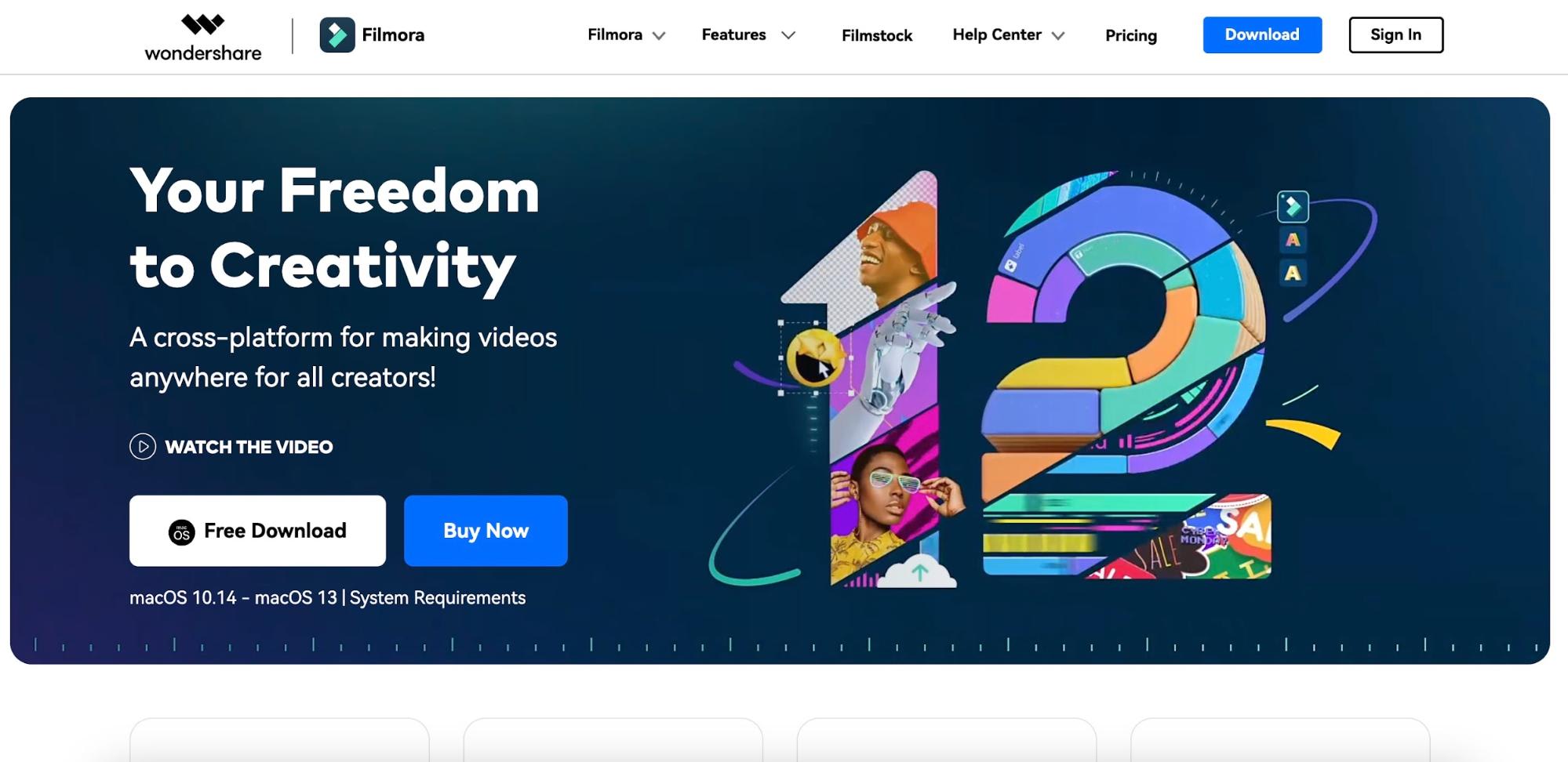
Filmora
Filmora by Wondershare is an AI-powered video editing platform designed for YouTube content creators. As one of the oldest tools on our list, Filmora has a traditional timeline-style video editing interface, with AI effects you can use to speed up your workflow.
Here are some of the editing effects that use AI technology:
AI background removal: Change the video background or remove it altogether
AI motion tracking: Identify faces and blur them—useful for YouTube channels to protect bystander privacy in public spaces.
AI silence detection: Removes gaps and periods of silence for a quicker-paced video. Also, it clears background noise.
AI auto beat sync: Sync videos and transitions with music instantly
AI instant mode: This is Filmora’s AI video generator feature. Using one of the 115 templates, Filmora identifies highlights and creates short videos from your raw footage or images.
You can also connect Filmora to your YouTube, Vimeo, or TikTok account to export videos in the right format faster.
Pricing
Filmora has a free trial version that lets you download videos with a watermark.
Since Filmora runs on your system, you’ll need to either subscribe or purchase it as a one-time payment, and then install it. Filmora has both Windows and macOS versions. Here are Filmora’s paid plans:
Annual: $67.97 a year.
Perpetual: $109.99 and access to Filmora 12 for life. You will need to pay a lower amount to upgrade to a new version of Filmora in the future.
Pros
Wide variety of AI effects
Great for YouTube videos and content creators
More affordable than other tools
Easy to learn and intuitive interface
Plenty of learning resources and a large community
Cons
Can be slow on laptops and lower-end computers
Perpetual plan only gives you lifetime access to the current plan, no future upgrades
Best for
Filmora is ideal for YouTubers and content creators, thanks to its traditional timeline style editor, AI-powered effects, and video templates.
If you’re a YouTube creator with at least 5,000 subscribers, you can benefit from Fiverr’s influencer program and earn best-in-industry commission rates or a flat fee per video.
Create stunning video ads and commercials
5. Pictory
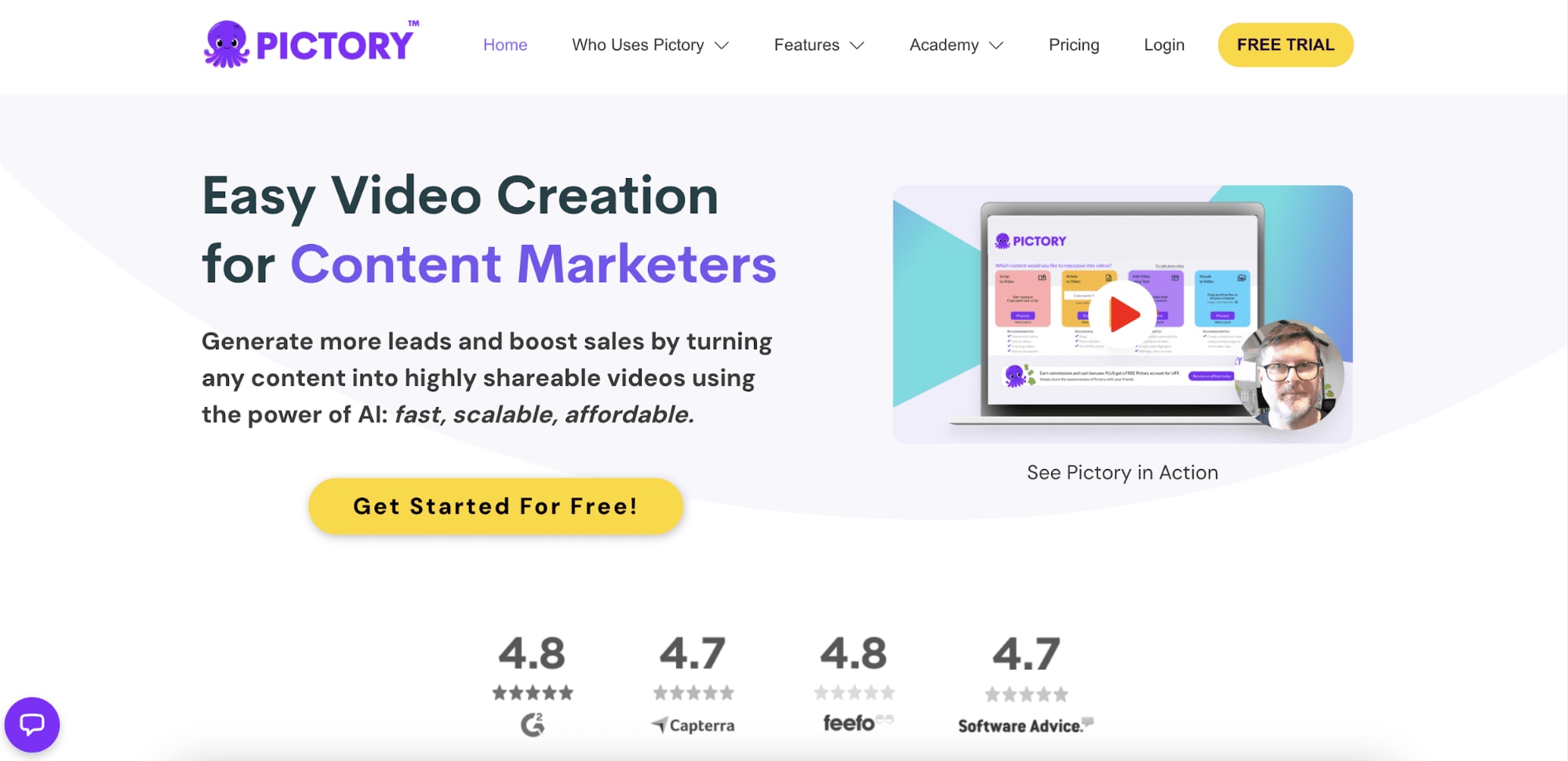
Pictory
Pictory is an AI-powered video generator and editor designed for content marketers. With Pictory, you can turn old blog posts into well-crafted videos. Pictory adds the footage, captions, music, transitions, and branding for an almost publish-ready video (you might need to make basic edits).
You can turn a written script into a video, a blog post into a video, or get short shareable snippets from Zoom videos and podcast recordings. Pictory doesn’t have too many AI video editing features, but it does let you directly splice footage by editing the transcript.
Pricing
Pictory has a free trial that lets you create three video projects of up to 10 minutes long.
For more videos, you’ll need to upgrade to a paid plan. All plans include access to more than three million royalty-free stock videos, animations, and images. Here are Pictory’s pricing plans:
Standard: $19 per month, billed annually. 30 videos per month.
Premium: $39 per month, billed annually. 60 videos per month.
Teams: $99 per month, billed annually. 90 videos per month.
You can purchase additional video credits when on the Premium or Teams plan.
Pros
Extremely easy to use, no prior skills required to make engaging videos
Best for short-form content
Automatic color correction and visual enhancement
Multiple format export
Multiple aspect ratios according to the platform
Text-to-speech AI voiceovers
Cons
Limited control over editing the music and effects
Captions aren’t always accurate
No multilingual features
Narration voices can sometimes sound too robotic
Best for
Pictory is incredibly easy to use and perfect for creators who need short-form professional video content. Even though Pictory is designed for small to mid-sized content marketing teams, the Standard plan is affordable and good enough for a solo content creator.
6. Veed
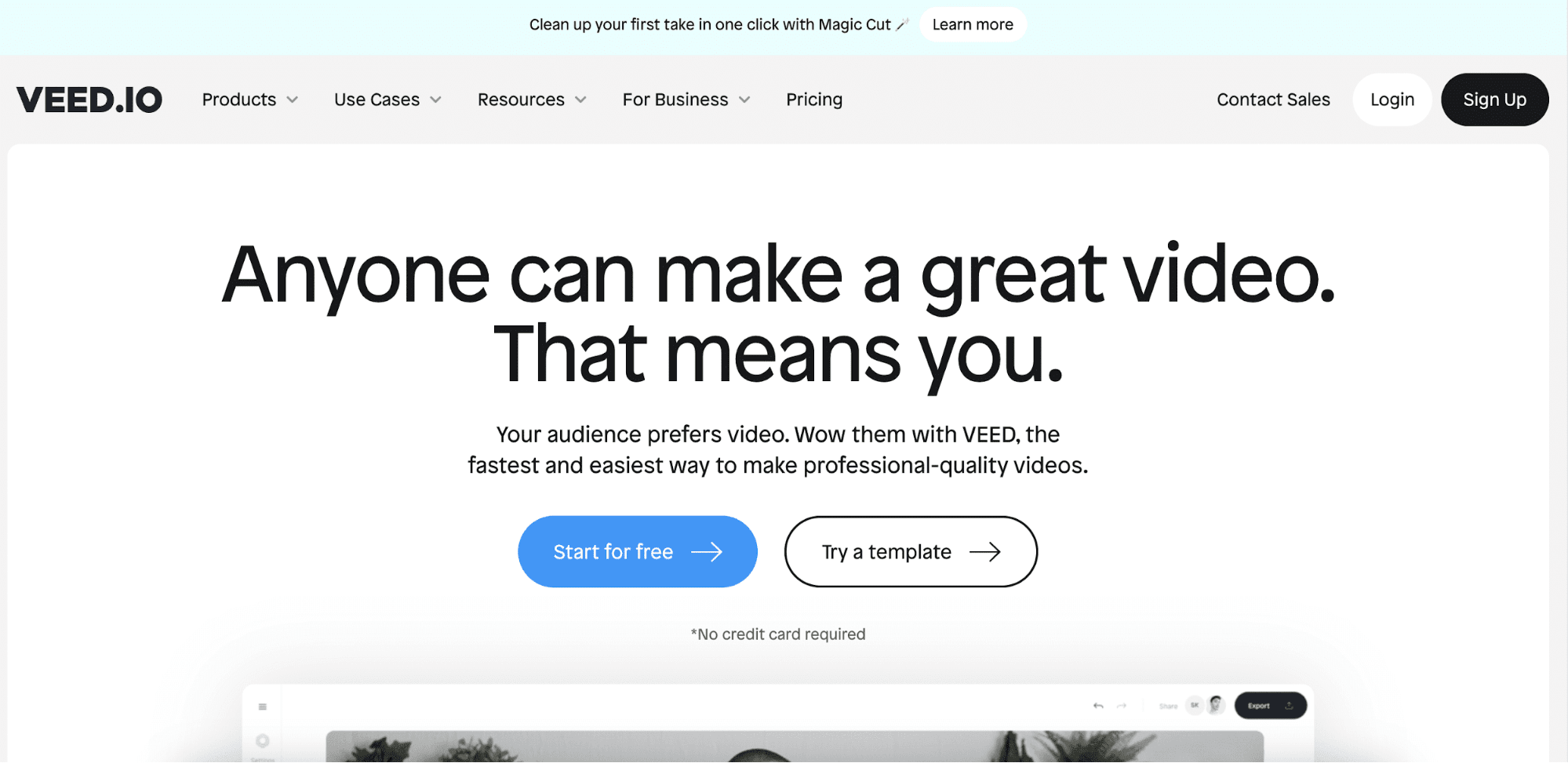
Veed
Veed is known as “Canva for video” and has been developing its product to include the latest AI technology features, such as eye contact correction, clean audio, AI avatars, text-to-speech, and stock media. Combined with Veed’s timeline video editing interface, it’s even easier to make high-quality videos.
Veed is a cloud-based video editing platform that makes team collaboration easy. You can also optimize each video for different platforms and translate words into over 100 languages. Veed also has an extensive video template library, which can help you with more professional marketing videos.
Pricing
Veed has a free plan that lets you upload up to 1 GB of content and export videos with a watermark. You also get an upper limit of 30 minutes of subtitling.
To export a video without a watermark, you need to upgrade to a paid plan:
Basic: $12 per month, billed annually. Exports videos up to 25 minutes. This plan does not include AI features like eye contact correction or audio cleaning.
Pro: $24 per month, billed annually. AI-powered editing, access to stock photos and videos.
Business: $59 per month, billed annually. Custom templates, video CTAs, and AI avatars. You also get access to video performance analytics.
Pros
Unique AI features like eye contact correction
Optimizes content for social media videos
Simplifies video production
Video editor has one-click snap-to-grid tools
Templates specifically designed for long-form video podcasts
Remove filler words and silences
Supports translation to 100+ languages
Text-to-speech tool comes with different accents and voices
Find an Expert Video Editor for Hire
Cons
No automatic AI video maker features
Most AI-powered features are only available in higher plans
No clip snippets feature, cannot instantly repurpose long videos into short-form videos
Best for
Veed’s video editor is great for beginners who don’t have experience with Premiere Pro or other software. Thanks to the wide video template library, Veed works best for talking head videos and other video marketing or corporate video material. Veed would be a great option if you want to create an online course.
7. Synthesia
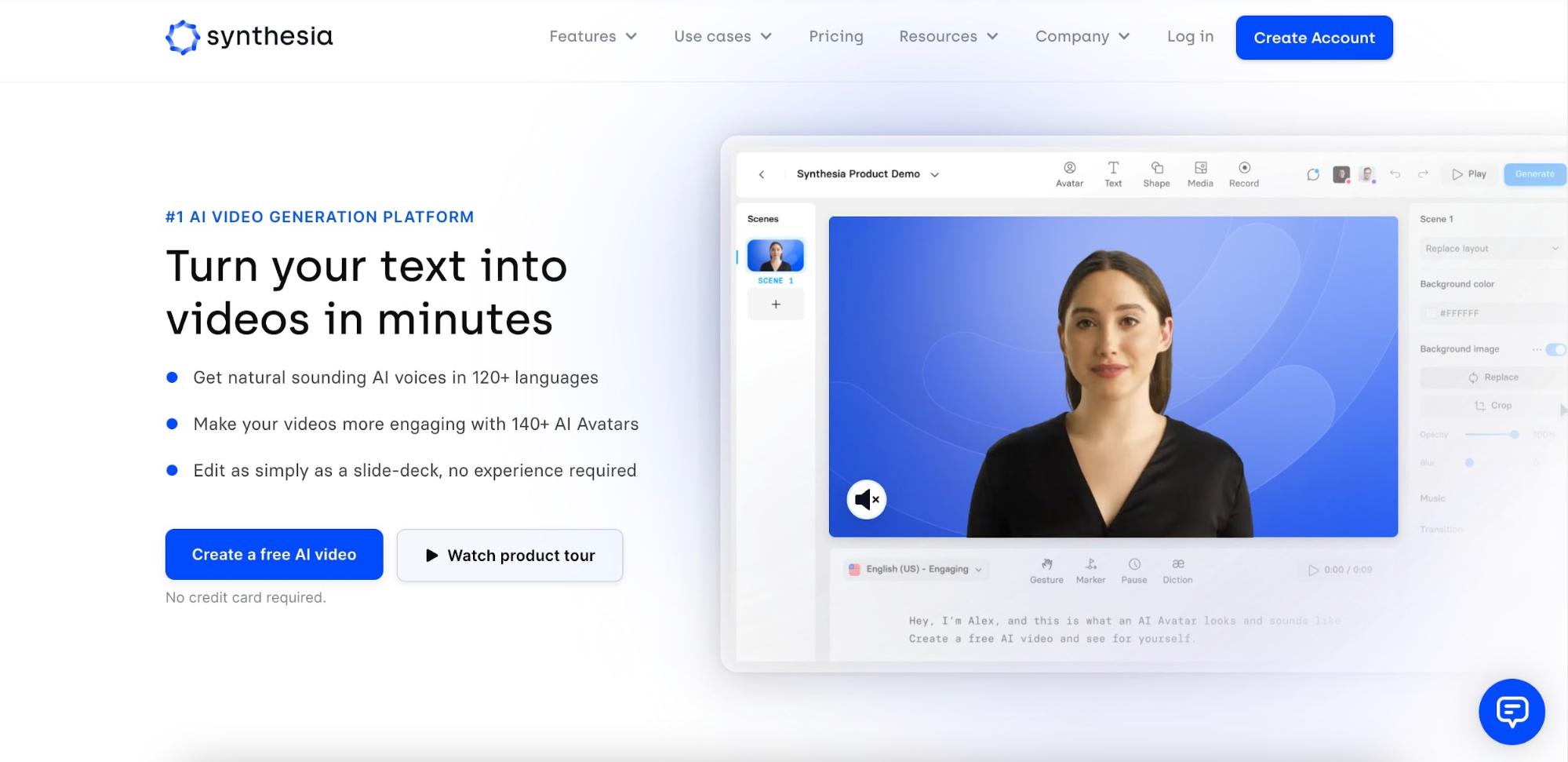
Synthesia
Synthesia is an AI video generator that uses AI avatars to make your videos more engaging. With over 140 avatars, you can choose a presenter to create talking head videos in more than 120 languages.
You can generate videos directly from text, such as a blog post or a PDF, and edit your video by editing the transcript as well. And if you don’t have written text, Synthesia has a ChatGPT integration to create a script instantly.
Can it fully replace human presenters? Synthesia avatars are convincingly real, as long as you don’t stare too hard! If the focus of your video is just the avatar, your audience could notice robotic expressions and delivery, which can be off-putting. However, when coupled with engaging text, transitions, stock media, or animations, an AI avatar in the corner of your video adds realism rather than detracting from it.
Pricing
Synthesia is the only tool on this list that doesn’t have a free plan or trial, but you can use its free AI video demo tool to create a sample video. You can also contact sales and request a product demo.
Here are Synthesia’s paid plans:
Personal: $25 per month, billed annually. You get up to 120 minutes of video. Synthesia only counts “new video minutes,” which is the edited content that you export.
Enterprise: Custom pricing for unlimited videos.
Pros
Most realistic AI avatars in the market
Transcript editing directly edits the video
More than 140 AI avatars
120+ languages voiceovers
Cons
Not affordable for all
Videos can get boring; not many templates, effects, or features for better visuals
Best for
If you don’t need AI avatars, Synthesia doesn’t offer any tools that you can’t get in a different AI video editing tool. But if you need to create lots of explainer or educational videos, Synthesia avatars can greatly improve your video efficacy.
8. InVideo

Invideo
InVideo’s browser-based studio wraps a prompt-driven “AI co-pilot” around a classic timeline, turning a line like “30-sec Instagram reel launching our spring sneakers” into a finished ecommerce video in seconds.
The model drafts a voice-over script, stitches royalty-free stock or your own clips, adds captions in brand fonts, and even picks a soundtrack that matches the beats. You can tweak every layer manually—swap B-roll from a 16 million-asset library, trim on the timeline, or clone your voice for last-minute script changes.
Real-time collaboration allows multiple editors to work on the same project, while silence trimming and auto-subtitle tools help speed up long-form edits. Finished videos export straight to 1080 p (Free) or 4 K (Max). The entire workflow feels closer to briefing an in-house editor than wrestling with raw footage—ideal when you need polished social ads fast.
Pricing
Free: 10 AI-minutes/week, four 720p exports/week, watermark.
Plus: $28 /mo (billed yearly). 50 AI-minutes, 80 iStock assets, 100 GB storage, unlimited 1080p exports.
Max: $48 /mo (billed yearly). 200 AI-minutes, 320 iStock assets, 400 GB storage, five voice clones, 4 K export.
Generative: $96 / mo billed yearly. 600 AI-minutes plus 15 minutes of “Generative” credits per month (full-length text-to-video creation), priority render queue, and the largest Shutterstock/iStock pool.
Pros
Prompt-to-video workflow cuts production to minutes
5,000+ templates, huge stock library
Built-in voice-overs and subtitle styling
Cons
Free tier watermarks every export
Long-form edits (>10 min) still feel clunky
Best for
Marketers who need ad-ready social videos without steep learning curves.
9. Kapwing
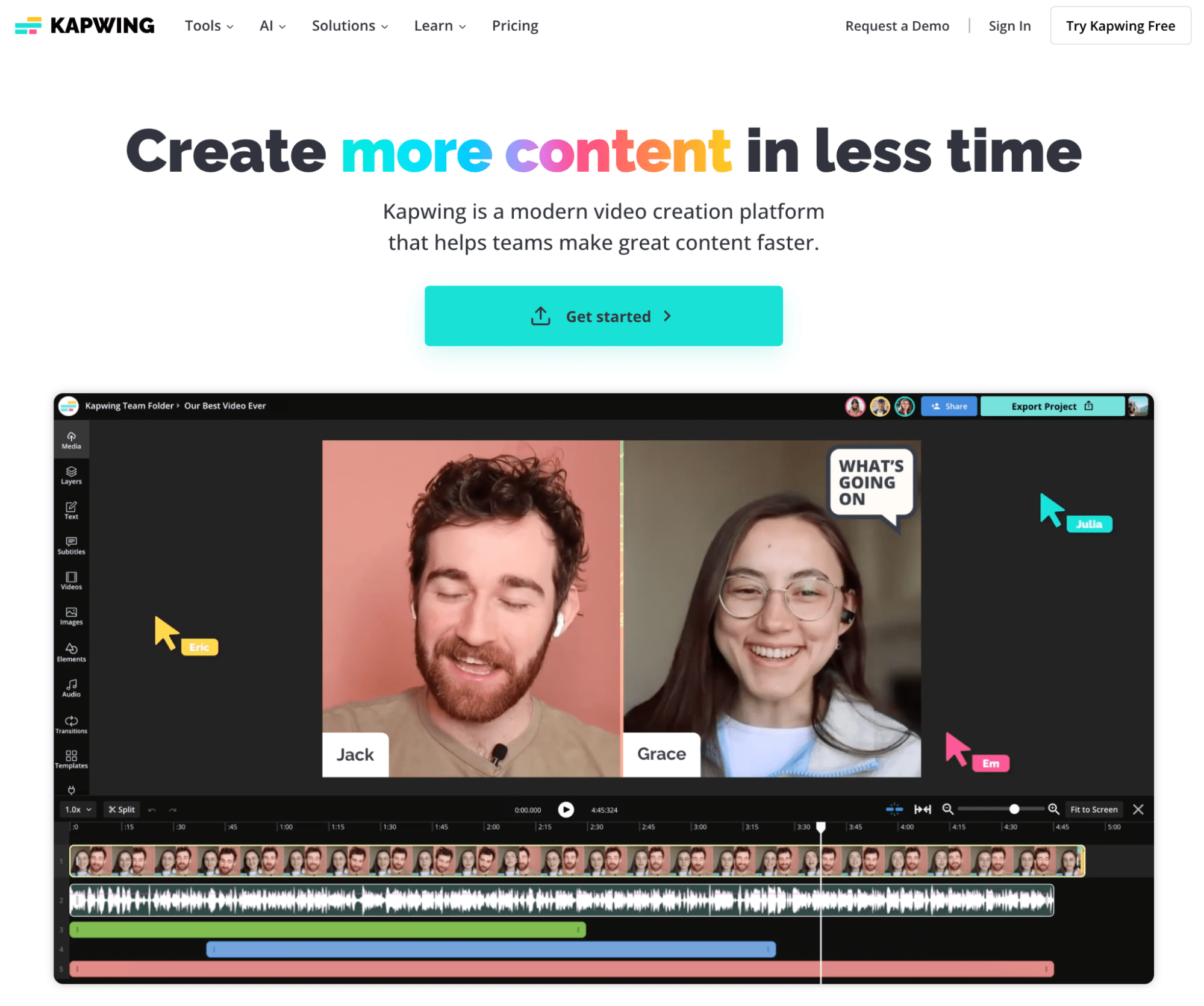
Kapwing
Kapwing packs serious AI under the hood. The tool auto-generates subtitles with near-live accuracy, cleans background hiss, corrects eye contact for vertical clips, and identifies highlight moments that you can export as TikToks with a click.
Collaborative workspaces keep assets, comments, and version history in one cloud hub, so a designer in LA and a copywriter in Berlin can tweak the same reel simultaneously. Recent rollouts added brand-kit locking, smart B-roll suggestions, and a text-to-speech engine that speaks in 20 accents.
Everything runs in the browser, yet renders up to 4K on paid tiers with no local installs—handy for Chromebook users. Kapwing’s blend of quick social media memes and longer training videos makes it a reliable Swiss Army knife for content teams.
Pricing
Free: 720p exports ≤ 4 min, watermark, 10 min auto-subtitles, 3 mins TTS.
Pro: $24/month (or $16/month billed yearly). 4K export, videos to 120 min, 300 min auto-subtitles, 80 min premium TTS, unlimited storage.
Business: $64/month (or $50/mo yearly). 900 min auto-subtitles, 200 min premium TTS, 30 min lip-sync video, two voice clones, higher AI-tool limits.
Pros
AI eye-contact, noise-cleaning, and subtitle tools in one place
Real-time team collaboration in the browser
No software installs
Cons
Heavy AI features are locked behind the Pro tier
Rendering large 4K projects can lag on modest laptops
Best for
Content teams repurposing talking-head videos into polished, captioned social posts.
10. Clipchamp
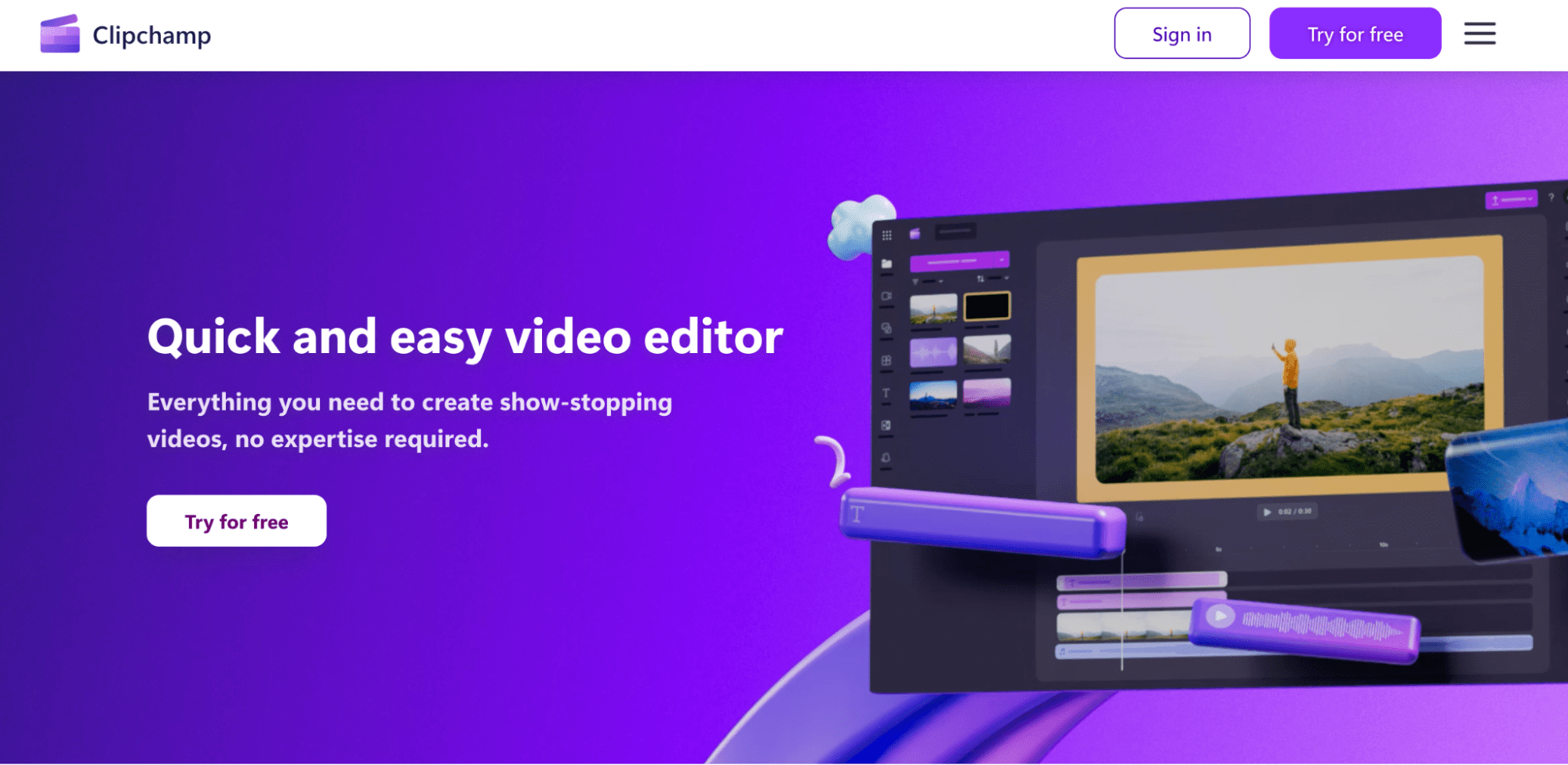
Clipchamp
Now bundled with Microsoft 365, Clipchamp gives Windows and web users a no-friction editor that stays free in full HD. AI auto-captions, silence removal, and a one-click “auto-cut” button shave hours from rough-cutting: the model finds dead air, trims gaps, and syncs b-roll to narration.
Brand kits, stock music, and motion titles sit a drag away, and finished videos publish straight to OneDrive, SharePoint, or even a PowerPoint deck for exec review. A desktop app caches assets locally, while the browser version keeps remote teams in sync.
The Essentials plan unlocks 4K, a larger stock vault, and priority export speeds, but many creators never outgrow the generous free tier—especially handy for educators or enterprise staff already paying for Microsoft 365.
Pricing
Free. Unlimited 1080p exports, core AI tools.
Premium: $11.99 per month. 4K export, premium stock, brand kit.
Pros
Full-HD exports are always free
Auto-cut, captions, and TTS are built in
Tight Windows 11 and OneDrive hooks
Desktop + browser flexibility
Large royalty-free library
Cons
4 K locked to paid tier
Web interface sluggish on multi-hour timelines
Limited advanced motion graphics
Best for
Microsoft 365 users who want seamless AI-assisted editing without extra subscriptions.
11. Lumen5
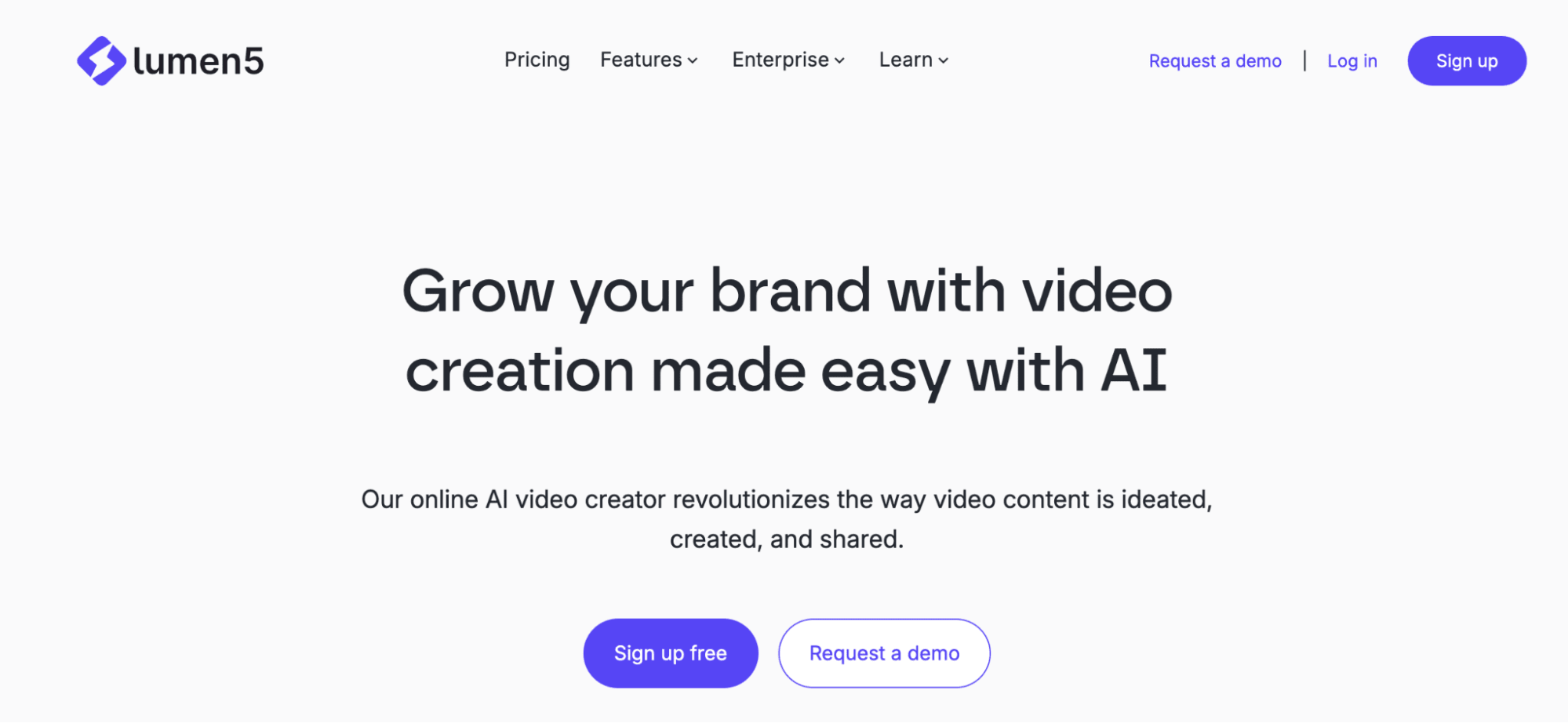
Lumen5
Lumen5 specialises in turning text into video. Paste a blog URL or drop in a white-paper PDF, and its NLP engine creates a slide deck. Key sentences become animated captions, stock footage and icons match the subject, and background music fades perfectly at scene breaks.
You can swap visuals, fine-tune timing on a straightforward timeline, or add AI voice-over in 20+ languages. Brand kits lock colours and fonts, while multi-aspect export (square, vertical, 16:9) readies the same story for LinkedIn, Instagram, and YouTube.
Recent updates introduced talking-head layouts that auto-crop a webcam feed beside your slides, ideal for quick thought-leadership clips. The whole process turns a 1,000-word article into a social video in under ten minutes.
Pricing
Community (Free): Up to five 720p videos per month, with a two-minute limit, and a Lumen5 watermark.
Basic: $29/month (or $19/month billed yearly). Unlocks 1080p, longer videos, and no watermark.
Starter: $79 / mo ($59 yr). Brand kit, 50 M Getty/iStock assets, custom colors and fonts.
Professional: $199/month ($149/year). Multiple brand kits, 5× media quota, priority support.
Pros
Best-in-class text-to-video conversion
Multilingual AI voice-over and captions
Smart Crop exports square, vertical, 16:9 in one click
Massive Getty/iStock library on paid tiers
Browser-based collaboration with version history
Cons
Template-driven layouts limit deep customization
Watermarked free tier
Audio key-framing is still basic
Best for
Content marketers who need to spin blogs, white papers, or scripts into platform-ready videos—fast.
12. Magisto
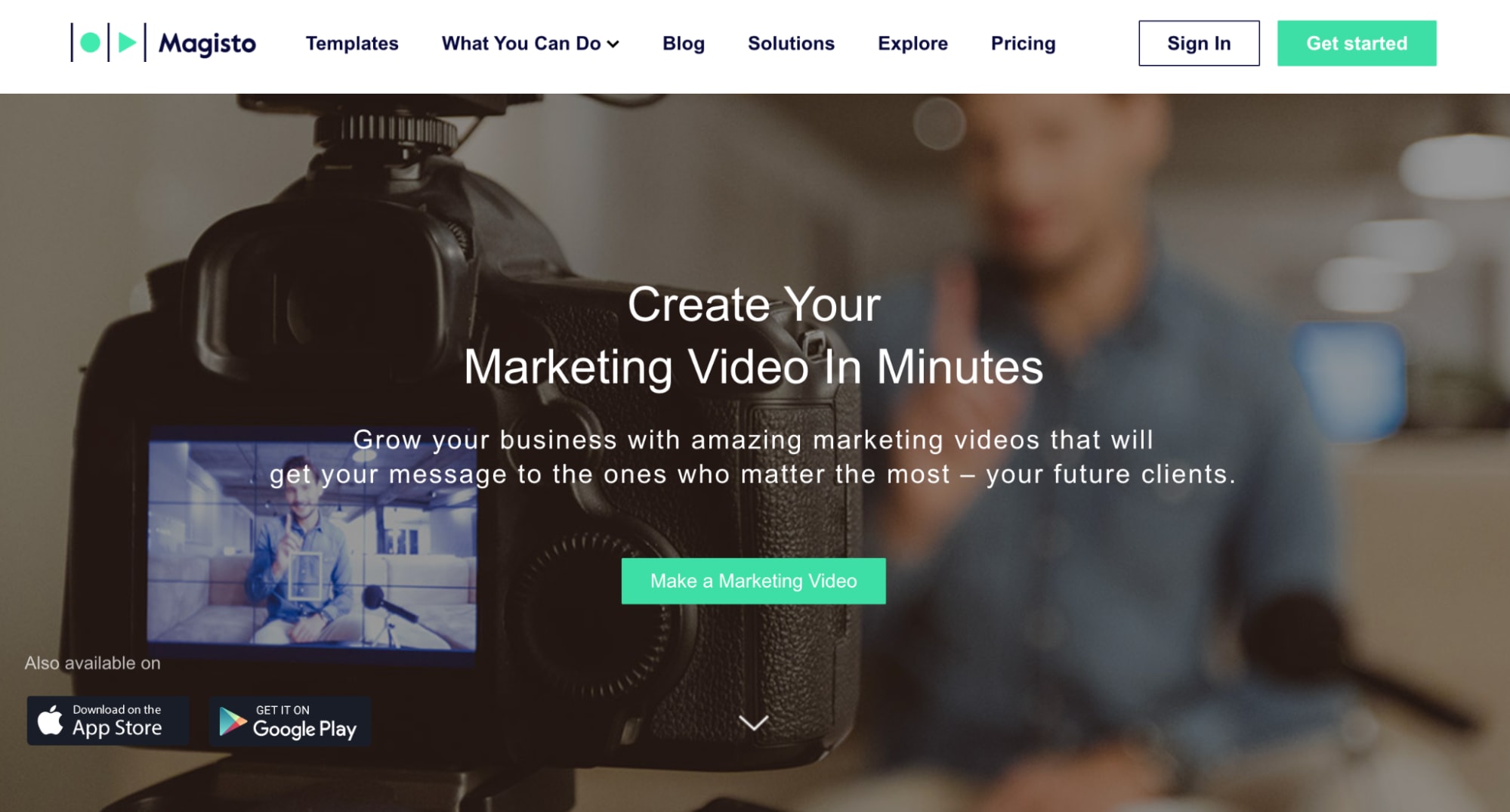
Magisto
Magisto’s smart editor analyzes raw clips for faces, motion peaks, and emotional tone. It then auto-assembles highlights, pairs them with licensed music, adds branded titles, and delivers a polished mini-movie in minutes.
Since Vimeo acquired Magisto, exports flow straight into Vimeo Create, unlocking ad-free hosting, lead-capture forms, and detailed engagement analytics without extra uploads. You can tweak font, colour, or clip order, but the magic lies in letting the AI churn through vacation footage, product b-roll, or customer testimonials while you focus on distribution.
Mobile apps mirror the web experience, so on-the-go businesses can shoot, edit, and publish from a phone. It’s speed over surgical control, but the results consistently outperform template-slideshow tools in terms of energy and pacing.
Pricing
Premium: $4.99 per month (billed annually). Up to 10-minute HD videos, premium styles, unlimited downloads.
Professional: $9.99/month (billed annually). Everything in Premium plus 3 M+ iStock HD clips & photos, advanced editing, brand colours & fonts, custom logo, and commercially licensed music.
Business: $34.99 / month (billed annually). Everything in Professional plus 25 M stock photos, Facebook Ads Manager export, email-marketing tools, website embeds, video analytics, and priority support.
Pros
Hands-off AI montage creation
Web + iOS/Android apps
Direct Vimeo hosting and analytics
Massive Getty/iStock media vault
Lead-capture overlays on the Business plan
Cons
Minimal manual fine-tuning after AI cut
No 4 K export
Big jump in cost from Premium to Business
Best for
Small businesses needing instant promo videos plus Vimeo hosting and marketing tools in one package.
Features to look for in AI video editors
Automatic transcript-based editing
Pick an editor that turns your audio into a written script with timestamps. Edit your video by just deleting text. This saves hours when working with interviews or podcasts. Look for tools that can remove "um" and "uh" automatically and close gaps after cuts. Good tools also allow you to view the video timeline for precise editing.
Text-to-speech capabilities
Built-in voice generators let you add narration without recording yourself. Look for natural-sounding voices that can change speed and emphasis. Check how many minutes you get for free. If your brand is important, find out if you can customize how words are pronounced.
AI-generated voiceovers and avatars
Computer-generated speakers can turn slides into videos quickly, but the quality differs. Check how realistic the lip movements and facial expressions look, and if you can create a custom character for your brand.
Ensure you have the necessary permissions to use the videos commercially and own the content you create. Check what languages they speak and how much extra time costs.
Background/object removal
Better editors can remove backgrounds or erase unwanted objects. Test how well they handle hair edges and moving subjects. Some let you add new objects or extend scenes. Remember that these features can slow down browser-based editors.
Multilingual support and subtitling
If you want international viewers, look for automatic captions in different languages and the ability to save subtitle files.
Good tools include punctuation, speaker labels, and styling options. Even better if viewers can switch languages. Check pricing carefully—many charge extra after a certain number of minutes.
Workflow integrations
An editor works best when it connects with other services. Direct links to cloud storage prevent confusion about versions. Quick uploads to video platforms save time.
Team features like shared resources and comments keep everyone on the same page. Check if the editor can connect to your existing workflow without manual uploads.
Hire an AI video expert today
AI video editing tools can cut hours out of the editing process, but sometimes create repetitive or basic video outputs. While this works for small businesses and creators just starting out with their content creation journey, it may not be good enough for higher engagement and traffic goals.
On Fiverr, you can hire professional freelance video editors for post-production services to get videos made specifically for your needs. You can also work with AI video art to create custom animation that can take your videos to the next level.
AI video editor FAQs
Is AI video editing better than manual editing?
AI streamlines repetitive chores—transcribing, rough-cutting, captioning—so editors can focus on story and polish. For straightforward social clips, the results can match or beat a junior human in speed and consistency. However, complex narrative work still benefits from a human eye for pacing, emotion, and brand nuance. In practice, the best workflows blend AI’s efficiency with manual fine-tuning.
Can I use AI video editors for free?
Most leading platforms offer a free tier or trial that allows you to test core features, such as transcript edits or auto-captions. Expect trade-offs: export resolution is usually capped at 720p, usage minutes are limited, and a visible watermark is applied. Upgrading to a paid plan removes those caps and unlocks higher AI quotas.
How do I remove watermarks from AI-generated videos?
Legitimately, the only way to do so is to upgrade to a plan that includes watermark-free exports; editing or cropping a watermark typically violates most terms of service. Before you pay, confirm the plan covers your required resolution and runtime so you’re not surprised by new limits later. Some tools also offer pay-per-export credits if you only need occasional clean outputs.
Will AI replace human video editors entirely?
AI handles mechanical tasks at lightning speed, but storytelling, brand voice, and creative problem-solving remain human strengths.
As algorithms improve, editors will spend less time trimming silences and more time on concept development, motion design, and directing AI systems. Rather than replacement, the trend points to a collaborative model where humans set the creative vision and AI accelerates execution.





